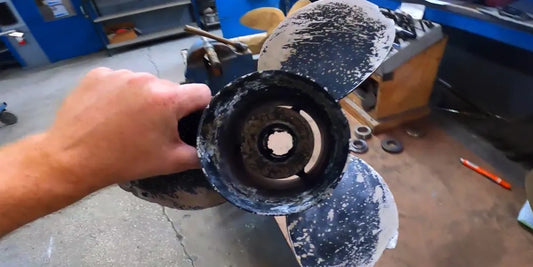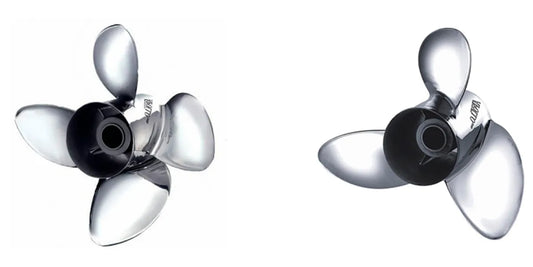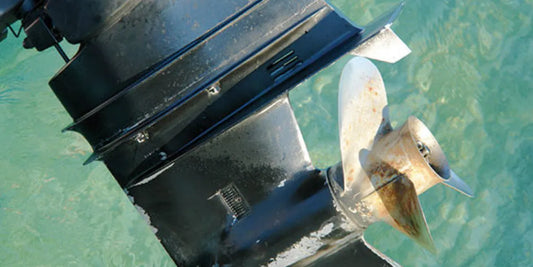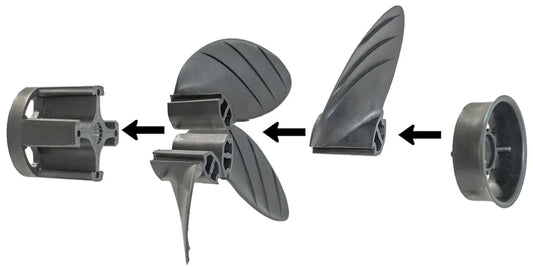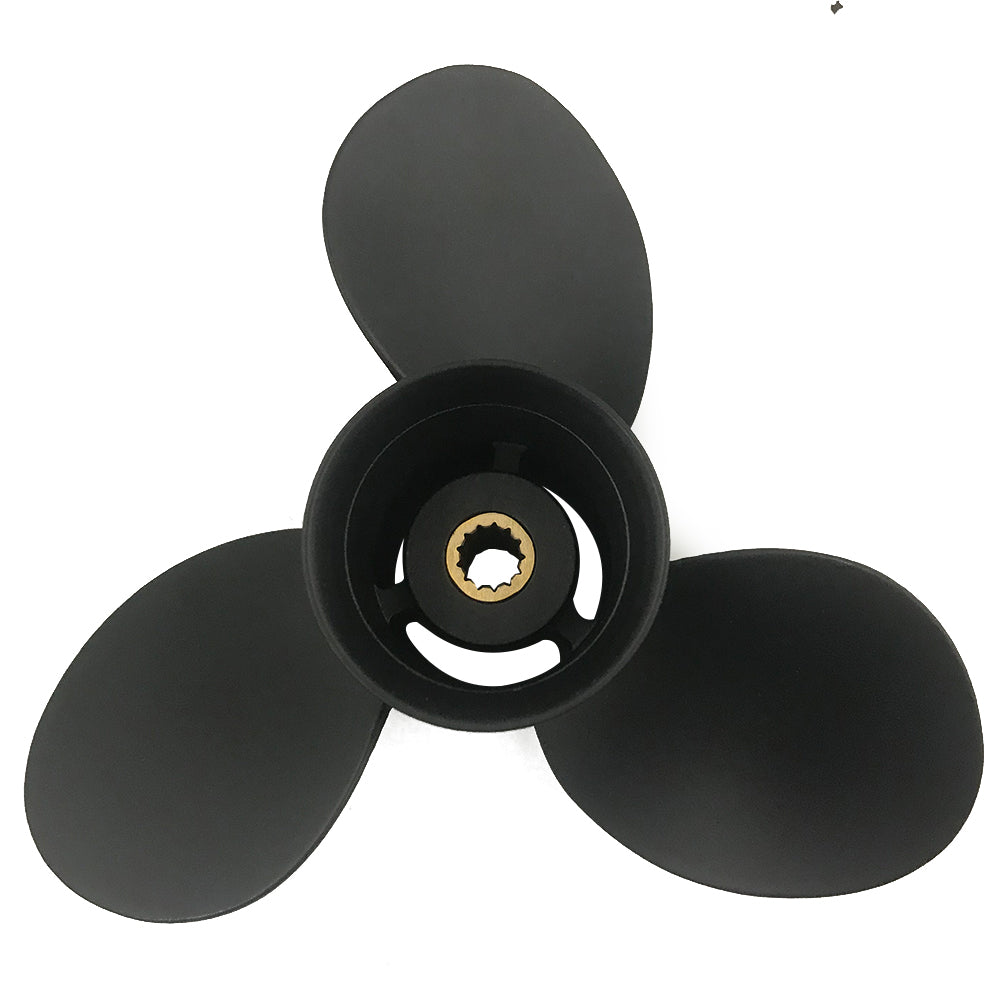When unmatched precision and performance on the water are sought, ballistic propellers rise to fame in every boat hobby and professional environment. These propellers with engineering innovations and state-of-the-art materials are meant to deliver on speed, control, and efficiency. Whether the craft is built for open water adventures, towing a heavy load, or simply wanting fuel efficiency optimizers, ballistic propellers cater to all. This article aims to draw your attention to how ballistic propellers revolutionize marine performance, unpacking the design innovations and their main features, and why this has become a must-have for anyone aspiring to fine-tune the boating experience. Gird your loins for a new concept of precision and power that will make the water time worth every moment.
What Makes a Ballistic Propeller Unique?

Design Features of Ballistic Propellers
Due to their meticulous designs, these propellers are considered very highly in the marine industry. They are capable of delivering peak performances under varying conditions. One signature feature is the precision casting of stainless steel, which affords it such high durability against corrosion even in the hardest saltwater environments. The material thus provides longevity with steady reliability.
The other chief innovation is their very finely tuned blade geometry. Ballistic propellers have thin, airfoil-shaped blades that maximize hydrodynamic efficiency, reducing drag while improving trust and responsiveness. The blades have cupped edges to grip water better for acceleration and steady performance in high-speed maneuvers. This design style also improves fuel efficiency with quicker planning for heavier loads.
Plus, there are often variations in the pitch along the blade, with the pitch increasing from hub to tip, thus dispersing power more smoothly over the propeller, improving handling, and reducing cavitation. These aspects of advanced engineering make the setup highly adaptable to a wide variety of boat and engine configurations, thus making it a great choice among both recreational boaters and working professionals.
Weighing in on what seems more important to you, ballistic propellers represent the perfect combination of modern design and functional practicality for optimizing any boat's performance.
Materials Used in Ballistic Prop Construction
Ballistic propellers use high-grade materials that emphasize durability and performance. Stainless steel is considered a principal option and is best suited to marine applications, given its corrosion resistance when in saltwater and considering the constant harsh treatment meted out to it. It also withstands high pressure in operation and does not undergo deformation, thus serving its function for a long time. Other advanced alloys could be combined to provide further resistance to wear and impact, which makes the propeller last longer.
These materials can be either moulded or machined using somewhat modern techniques that allow the making of very delicate blade designs while maintaining the structural integrity of the material. For lighter performance, aluminum is used in some propellers, providing a balance between strength and cost. Each material is chosen and treated to optimize the hydrodynamics for smooth working and maximum thrust. These materials produce highly durable propellers that provide maximum thrust and unmatched efficiency for various boating applications.
Understanding Propeller Efficiency
Propeller efficiency characteristics depend on design, materials, and operating circumstances. One such parameter is the blade pitch. Pitch refers to the distance a thrusting propeller would move through a solid substance in one revolution. While a higher pitch can mean higher speeds, there is a chance that the overall efficiency may decrease if the propeller is not chosen in harmony with the power of the engine and mass of the vessel. Another parameter governing efficiency is the propeller's diameter: through their rotation, they displace water. Larger diameters displace more water, creating more thrust and being best suited for bigger boats; smaller diameters favor speedier craft.
The number of blades will, therefore, εxcercise influence upon efficiency: scant blades tend to reduce drag and so grant high speeds, whilst an increase in the number of blades produces greater thrust and smoother operations, which are essential for larger vessels or those working amidst rough waters. Then come the shape and surface profile of the blades, granting all hydrodynamic considerations to modern designers to lessen cavitation-overperformance loss and potential damage resulting from the sudden collapse of vapour bubbles on the blade surface.
Furthermore, operating conditions such as water temperature, salinity, and even debris hamper efficiency. The cooler and denser the waters, the better thrust they impart, thus demanding more resistance to push against the blades. The prop only attains top performance if regularly maintained. Therefore, growth has to be cleaned off, and minor dents and scratches must be repaired. By considering these core factors, boaters can harness maximum efficiency from their prop for a whole spectrum of applications.
How Does a Michigan Wheel Ballistic Enhance Performance?

Role of Stainless Steel in Michigan Wheel Ballistic
Stainless steel is among the ingredients that make the Michigan Wheel Ballistic propeller a good design. Renowned for its strength and corrosion resistance, stainless steel allows durability and a strong performance in severe marine environments. The material's stiffness allows the blades to be thinner for more hydrodynamic designs, thereby limiting drag and promoting efficiency in acceleration, top speed, and handling.
Furthermore, stainless steel can withstand the powerful engines' immense torque and stress. This material will not deform, producing good performance throughout its service life. Since it is corrosion-resistant to saltwater, it is best to use it in both fresh and saltwater. Real-world observations and professional opinions have confirmed that stainless steel propellers usually perform much better than aluminum ones in terms of lasting power. Therefore, this is the preferred choice among serious boaters who want to give their vessels the best shot at performance and reliability.
Impact of 3-Blade Design on Speed
Known to have found an advantageous balance between speed, thrust, and efficiency, the 3-blade propeller family remains a favorite among boaters. A few questions arise: Why do propellers with 3 blades tend to produce greater top speeds? Because with fewer blades, you get less drag and less surface area submerged in water. Besides, with three blades, you can almost always expect efficient power transfer from your engine, leading to superior performance across various situations. They therefore fit perfectly for those applications in which higher speed is expected: recreational boating or racing.
The smooth design of the 3-blade propeller prevents, to a large extent, cavitation—air bubbles disrupting performance—and thus results in smooth navigation and less wear on the propeller. Due to their design, 3-blade propellers offered the best performance most of the time under light or medium loads and provided optimum efficiency and stability at high speed. However, it is a matter of trade-offs; being very good while providing the best speeds, they can slightly lose grip and torque when compared to 4-blade configurations, especially when towing or carrying heavier loads.
If a shipowner cherishes top-end speed and does not want to compromise on the versatility of mere general-purpose performance, then the 3-blade propeller is still the best option. Thanks to major metallo- and hydrodynamic innovations, modern 3-bladers feature improved blade geometries and lightweight materials that further enhance acceleration, fuel economy, and durability. This makes these systems key for competitive and recreational boating applications alike.
Advantages of Michigan Wheel Ballistic Propellers
The Michigan Wheel Ballistic Propellers are distinguished by their superior engineering and performance capabilities; therefore, they are vehicles opportune to steer purchasers in the marine industry. Built with blade geometries that afford maximum efficiency in thrust with minimum drag, thus allowing smooth acceleration and optimized fuel economy, these propellers are formed. Precision casting and corrosion-resistant stainless steel give them high durability to resist severe marine environments and extend their working lives considerably.
On the downside, they are versatile and come in many sizes and pitch configurations to suit many engine types and vessel requirements. Meanwhile, their thin and efficient blades reduce cavitation and improve the handling characteristics, giving more stability and consistent performance. For recreational boating, fishing, or competitive racing, Michigan Wheel Ballistic Propellers are recognized for power and reliability, attracting any marine enthusiast.
Why Choose Stainless Steel Propellers for Your Boat?

Durability of Stainless Steel in Marine Environments
Stainless steel fortifies its reputation for greater durability, especially in challenging marine environments where exposure to saltwater, humidity, or even constant mechanical stress can be hazardous to a lesser material. The primary factor causing corrosion resistance in stainless steel is chromium, which reacts with oxygen and forms a thin, protective chromium oxide layer on the surface. This natural healing barrier prevents rusting and other degradation despite long periods of being in saltwater; hence, stainless steel propellers, fittings, or parts may be well-chosen marine components.
Styl steel can maintain even higher strength and hardness than aluminum or plastics, helping it resist deformation, chipping, and cracking during high-speed impact by debris or changing water pressure. This sturdy condition means greater reliability and longer life span of the significant parts for boaters who operate frequently in rock or debris-filled waterways. Studies have revealed that the vessels equipped with stainless steel propellers experience enhancement in maintenance costs over time because they need less frequent repair or replacement due to material failure.
One of the benefits stainless steel offers in marine applications is the ability to retain maximum performance and efficiency even in the harshest conditions. Stainless steel propellers can generate the highest thrust level at the most outstanding torque, ensuring fuel efficiency and superior accuracy in handling. This worthiness has made stainless steel a prime pick for all recreational and commercial boating applications, bestowing a sense of security and long-term value to every marine enthusiast. Stainless steel has made a landmark, combining strength, corrosion resistance, and performance to see it stand the test of the harsh realities of marine environments.
Performance Benefits Over Aluminum Propellers
There are significant advantages of stainless steel propellers compared to their aluminum counterparts, principally in terms of durability, precision, and performance. While aluminum propellers are cheaper and lighter in weight, they can bend, crack, or warp under stressful situations, perhaps hitting underwater debris or operating at very high speeds. Stainless steel gives more strength and resilience while maintaining its shape and dimensions in demanding environments.
In addition, stainless steel props perform better because they can have thinner blades with greater engineering precision. The thin and fine blade design will help reduce drag in the water while thrusting maximally for quick acceleration, high top speed, and fuel savings. According to research and many user reports, a boat running on stainless steel propellers usually can witness a 3-5% increase in generic performance areas, including speed and efficiency, more than those running aluminum propellers.
Also, stainless steel's corrosion resistance is fantastic enough to be used in both salt and fresh waters with longevity and minimum maintenance. For serious boaters who want long-term value and outstanding performance, stainless steel propellers are definitely an investment worth considering to withstand the ups and downs of the marine environment.
How to Select the Right Outboard Propeller?

Factors to Consider: Diameter and Pitch
Getting the sizing of an outboard propeller right involves understanding the diameter and pitch of each other to make them suit your boat's efficiency and performance. The diameter is the total width of the imaginary circle traced by the rotating blades of the propeller. Larger diameter propellers do the job for heavy boats as they generate thrust to move the heavy load; small diameter ones go for lighter, faster boats where speed takes precedence.
Pitch describes the distance the boat theoretically travels with one complete propeller revolution, without any slippage. Therefore, a higher pitch means the boat travels farther with one rotation and is used for speed purposes. In comparison, a lower pitch gives better working acceleration and will pull the ship with more force, which helps to tow and get the boat on plane faster. Ideally, a balanced diameter-pitch combo custom-made for your boat and all your boating activities will go a long way in elevating performance, better fuel economy, and less engine strain. Considering all these factors within your engine's power range and in line with the manufacturer's recommendations will make your water experience a memory to cherish forever.
Matching Propeller to Engine HP
Choosing the right propeller accommodated for your engine's HP is necessary to ensure that a given speed is achieved, and the engine remains in good condition. The propeller needs to be matched with an optimum RPM range provided by the engine for optimal efficiency. For engines with powers over 150 HP, the diameter and pitch medium are usually quite large so that a lifter thrust and speed balance is achieved. Smaller engines, less than 50 HP, usually use smaller diameters and greater pitches to provide maximum speed for lightweight boats.
The manufacturers of each engine typically indicate the ideal RPM range, and you must adjust your propeller selection within this peak performance range. Suppose you have an engine that performs best between 5,000 and 6,000 RPM, and the propeller chosen yielded RPMs below or above this range; that will mean breakdown of excessive fuel consumption, more wear, and poor performance. Using a propeller that harmonizes with the characteristics parameter-wise, including the number of blades, primary material (steel or aluminum), and pitch proportionally to the conditions, could give a massive boost to the capability and efficiency of the boat. Constant monitoring of engine performance and water conditions ensures you achieve set goals continuously.
Understanding Hub Systems and Compatibility
Hub batteries represent a critical point of failure for the functionality of the boat propeller, as the hub must sit between the engine and the propeller. A well-designed hub system absorbs vibration, lowering the risk of damage induced by sudden impacts on the propeller itself, allowing smooth power transmission. Today, rubber or plastic-hybrid-type hub systems cushion the propeller while protecting the engine drivetrain for longer life.
A good parameter to follow when selecting a hub is engine and propeller compatibility. Many manufacturers claim their hubs are for a particular make or model, making it crucial always to check the specs of a hub before purchase. Other considerations that need to be considered include issues such as spline count, shaft size, and hub material—all critical considerations that must mesh well with your propulsion system's design. Also, modular hub systems are getting very popular because of their flexibility: the user can change propellers without replacing the entire hub, which is a significant saving and convenience in the long run.
With the hub system designed for and chosen for your setup, you can ensure that your marine equipment benefits from improved performance and much less maintenance while enjoying longer equipment life. If you research, understand, and choose compatibility, you can help ensure the reliability and efficiency of a boating trip.
Exploring Ballistic Stainless Steel Technology

Manufacturing Processes of Stainless Steel Propellers
A set of manufacturing processes for stainless steel propellers involves precision engineering, materials technology, and meticulous craftsmanship. In my understanding, one first selects the best-grade stainless steel, which is picked for its strength, corrosion resistance, and ability to withstand adverse conditions in a marine environment. The raw material is melted and cast into molds that ascertain the basic outline of the propeller. The casting should be executed with utmost care because this bestows upon the product a structure through which it receives stress and endurance under extreme conditions of a high-performance marine environment.
The propeller is machined following casting, allowing for shape and dimensional refinement. Usually, the machining process will be done with CNC machines, allowing for a symmetry of blade geometry and perfect alignment. This process is critical as even the slightest deviation affects the propeller's performance and consequently the vessel's fuel consumption. Polishing of the propeller follows. Polishing improves appearance while reducing drag by presenting a smooth surface with the least water flow resistance. After being polished, the propellers are subjected to quality inspection and performance testing to ascertain that each propeller meets stringent industry requirements and provides the best performance under actual working conditions.
From my view, this is the painstaking balance between science and art. The engineers work on intricate technical details to achieve better efficiency and durability, while the craftsmen ensure each blade is impeccably finished. Thus, stainless steel propellers are manufactured with the utmost reliability and power and are therefore essential for any marine enthusiast or professional.
Advantages in Racing and High-Performance Applications
From my perspective, stainless steel propellers have undiminished advantages in racing and high-performance applications. Their strength and durability allow them to attract and withstand enormous forces and stress during high-speed operations. In contrast to aluminum propellers, they do not flex under load, thereby delivering the best possible performance and efficiency in extreme conditions. This firmness contributes to faster acceleration, higher top speeds, and more precise response, which are paramount in a competitive arena.
In short, superior hydrodynamic design is the benefit. Steel propellers give you optimum thrust and maneuverability, which are crucial for the tight cornering and quick recovery times that a race demands. Stainless steel's corrosion resistance also assures long-term performance, especially considering saltwater frequently comes into play with high-performance vessels. Proving their reliability and consistency, stainless steel propellers are, in my mind, the apparent choice when every fraction of a second matters.
Reference Sources
-
2024 Innovations in Body Armor and Ballistic Materials - Discusses advancements in ballistic materials, including new polyethylene fibers for enhanced applications.
-
Innovations in Ballistic Composites—Transforming Modern Defense and Security highlights revolutionary manufacturing processes like 3D printing and automated fiber placement in ballistic composites.
-
'True Ballistic' Training for True Battle Readiness - Explores Saab's advanced BT46 technology for realistic ballistic training.
Frequently Asked Questions (FAQs)
Q: What are the advantages of using Michigan Wheel Ballistic Stainless Steel propellers?
A: Michigan Wheel Ballistic Stainless Steel propellers are built for high-speed performance. Thanks to their highly cambered blade sections and tapered leading edges, they offer speed and bow lift superior to other propellers. They are fitted for cut-throat speed and handling.
Q: How does the Michigan Wheel Ballistic stainless steel propeller enhance boat performance?
A: The Michigan Wheel Ballistic stainless steel propeller enhances boat performance with a sharper hole shot, better top-end speed, and great handling. A 3-blade stainless steel configuration and a hub kit design reduce drag and increase speed.
Q: Why is the blade design important in Michigan Wheel Ballistic propellers?
A: The blade design in Michigan Wheel Ballistic propellers is crucial to achieving good performance. This 3-blade stainless steel design has highly cambered blade sections and tapered leading edges that give great hole shot, speed, and easy maneuverability, making it a good proposition for races and high-performance boating.
Q: How does the XHS hub kit affect boat propeller performance?
A: The XHS hub kit enhances the performance of a boat's propeller by ensuring a tight and efficient connection between the motor and propeller. This lessens vibrations while boosting the prop's overall efficiency and life span, especially in high-performance conditions.
Q: What are the benefits of stainless steel outboard propellers over others?
A: Stainless steel outboard propellers are more durable and perform better than other propellers. They are less likely to be damaged and transfer power effectively due to their rigidity and design, such as the tapered leading edges and 3-blade configurations found in Michigan Wheel Ballistic series stainless steel outboard propellers.
Q: Why does the hole shot mean so much for a propeller's performance, and how does it affect boating?
A: The holeshot is the acceleration from a standing start. This means the boat will be on plane very quickly and is consequently very useful for activities like fishing and racing. Propellers like the Michigan Wheel Ballistic 3-blade are geared toward optimizing holeshot performance by fast acceleration and overall better speed.
Q: How do tapered leading edges make a boat propeller more efficient?
A: Tapered leading edges act against drag and increase a boat prop's efficiency; this design feature causes smooth water flow over the propeller blades. Such a design also increases speed and saves fuel, which is a much-needed attribute in both recreational and competitive boating.
Q: What importance does horsepower have in choosing the proper propeller for a boat?
A: Horsepower is an important factor for proper propeller selection, as it dictates the propeller's capability to harness the motor's power output. High-performance propellers like the Michigan Wheel Ballistic have been designed to maximize the efficiency and power transfer of motors with higher horsepower, ensuring optimal performance and speed.
Q: How does a ballistic boat prop differ from other propellers?
A: A ballistic boat prop has high-performance design features that typically include 3-blade stainless steel construction, highly cambered blade sections, a focus on speed, and better bow lift. These props are designed to deliver better acceleration and top-end speed, facilitating performance-oriented boating.


